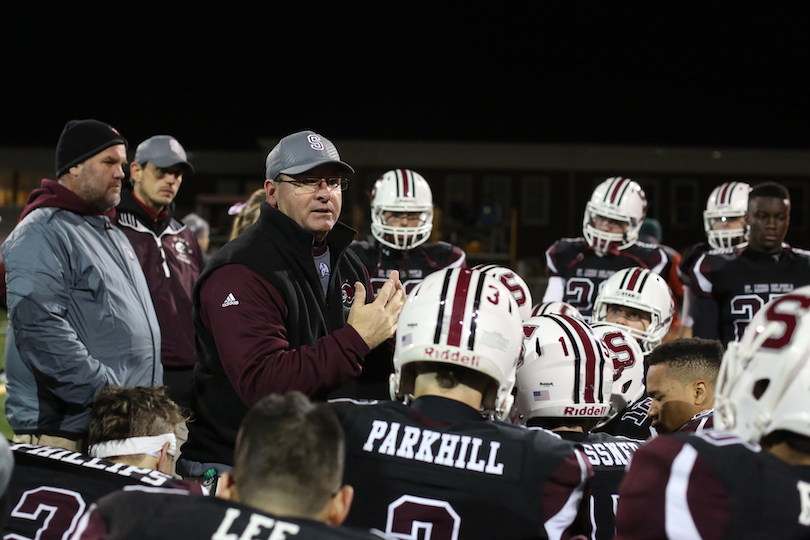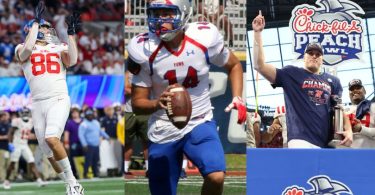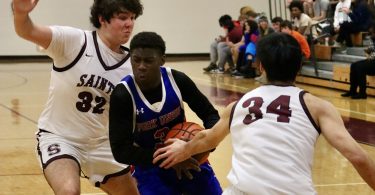Even when you’re the opposing coach in one of the area’s most storied private school rivalries, there’s something about playing football on Blue Ridge’s field that can be a little awe inspiring.
The field is situated so that you get a panoramic view of the mountains that surround the campus. The timing of the traditional matchup doesn’t hurt either.
“It’s late October, it’s freaking awesome,” said STAB football coach John Blake. “It’s like, we get to play here? And generally it’s always a great game.”
That’s how Blake, who’ll coach his last game in the local area Saturday in the renewal of a Blue Ridge rivalry that has been shelved since 2016, talks about everything when it comes to STAB football. He’s always excited, always appreciative of the opportunity, the surroundings, the game, the chance to compete. It’s fitting that his last game locally will come on the road at a place where he’s been in some absolute classics against a program that was responsible for his lone loss in his first year at STAB.
Those are the kind of things that have made the last 25 years and 176 wins where he’s coached countless players so special. Blake has built a family within and surrounding the program while raising his own family alongside the program that he’ll walk away from when he retires from his position as head football coach for the Saints at the end of this season.
“The people, that’s the one thing I’m going to miss — the relationships,” Blake said.
They’ll miss him too, though the ones he’s already impacted are never really far from Blake or at the very least they aren’t far from his lessons and the guidance he provided in their formative years.
“He has been a mentor to so many young men like myself,” said Shane Palmateer, a 2012 graduate who played running back and linebacker for the Saints. “His successes on the field are unparalleled but his true legacy was his ability to help develop young boys into future fathers, husbands, and community leaders.”
Blake is the area’s longest tenured high school football coach currently, and his success and longevity is impressive, especially since he took over a program that went 1-8 the year before he arrived and had 18 kids on the roster his first year. But what’s perhaps even impressive is how many times Blake has rebuilt and restored the program. In those initial years he built by seeking out athletes throughout STAB from the soccer program to the lacrosse program, even players locked into other sports that he’d known since they’d played when they were little from coaching football in the area. Blake was the head lacrosse coach and a football assistant at Western Albemarle before heading to STAB.
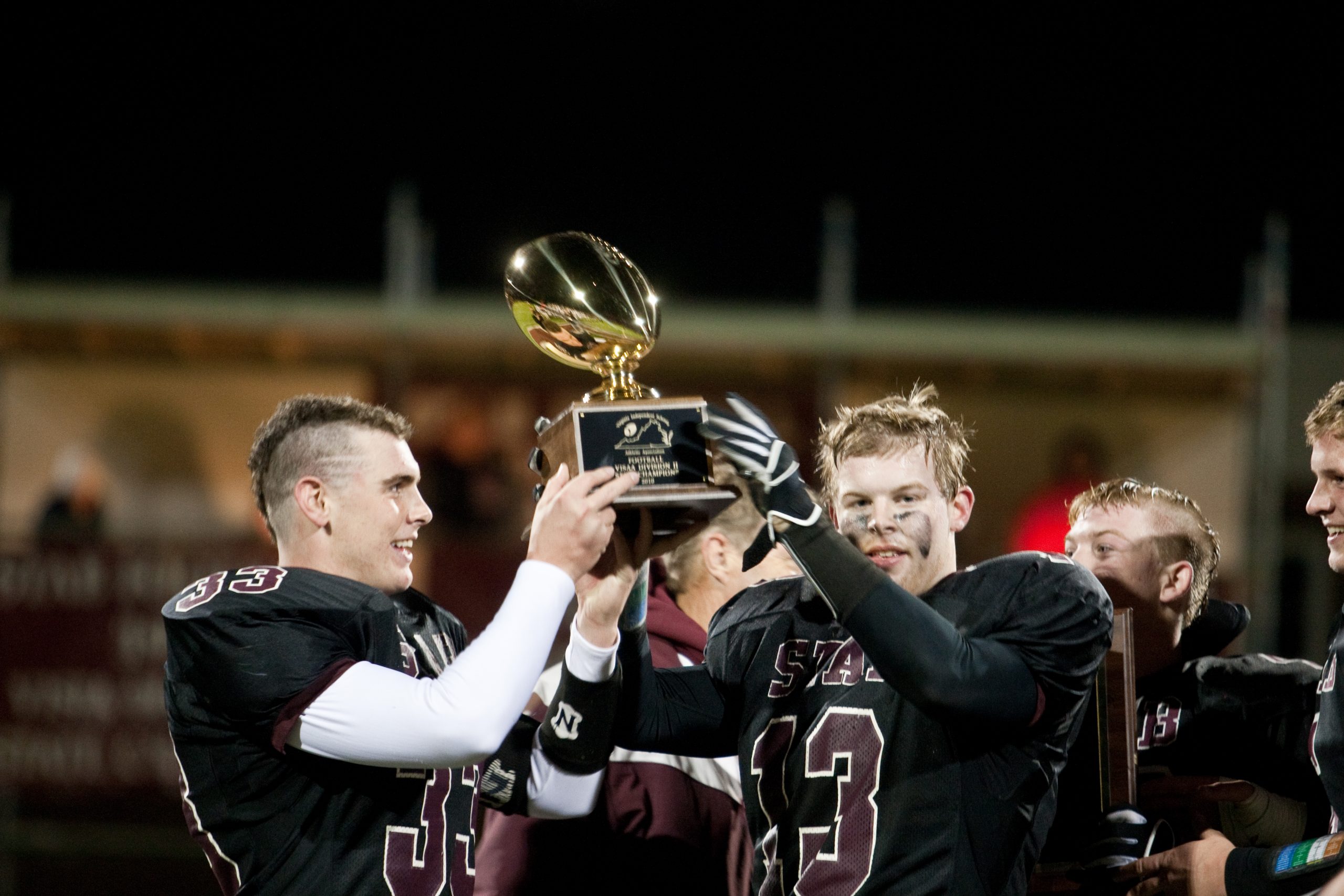
STAB celebrates the 2010 state championship.
Most people think of the span in the early 2000s where Blake won a big chunk of his six state titles when the rosters included Chris and Kyle Long as well as Brian Linthicum and Colin Pehanick, who all went on to college and in the Longs’ case, the NFL. But there’s a dip in performance after that run where the Saints won state championships in 2006, 2007 and 2010 and a particular bottoming out in 2012 when the Saints went 0-10 or when the Saints went to eight-man football in order to rebuild the program the last three years.
“Football is all cycles, but you find a way to build back from the cycles so that you’re reaching the same heights that you were before,” Blake said. “Now, 2012, I got rid of everything. We repainted the helmets, got rid of the jerseys and I even threw away the coaching gear for that year.”
Blake also went to work immediately on restoring the Saints and just two years after that frustrating campaign in 2012 (a team that included future NFL lineman Aaron Stinnie), STAB was back in the state title game, battling for another potential title before falling to Trinity Episcopal.
That process has always been complicated by the small rosters STAB has, just like most private schools their size. Blake was aware immediately that those rosters would be a recurring challenge, to the point that he had Billy Haun, the VHSL executive director who’d coached at Western while Blake was there, connect him with coaches in Haun’s native Southwest Virginia who also coached with small rosters.
“They were like, well, everybody’s got to learn everything, you know, because you don’t know,” Blake said. “I mean, you’re two or three ankles away from ‘who’s going to be quarterback.’ You know, he might be a guard one day and he’s a quarterback the next day.”
In the 2008 season, seemingly every viable ball carrier including standout Aaron Jones and Alex Asher, usually a tight end or wideout was injured, forcing Blake to turn to a linebacker, Quincy September, a South African import with more rugby experience than football experience at that time in a rivalry game with Covenant. September delivered, making seemingly every tackle on defense and every big play on offense.
“The thing John learned at STAB was you had to be much more flexible with a lineup and get the most out of them,” said Doug Tarring, the former STAB AD who hired Blake. “It was a teaching staff as much as it was a coaching staff.”
Blake often had like-minded coaches on his staff, coaches who could think outside the box, from Dave Riddick to Tom Paquette to Hunter Price. Those assistants helped him carry out that vision because there’s no way Blake could teach everything to everyone.
That roster size and the everyone-has-to-learn-everything approach also altered Blake’s perspective on how he evaluates players. He’s never been that married to a particular archetype at positions, instead focusing on what exactly it is you’re trying to do and prioritizing that.
“He had an uncanny ability to put his players in the best positions for them to excel and to optimize the team’s chance to win,” said Sean McChesney, a 2001 graduate who played quarterback for the Saints. “He was brilliant at building a roster and then playing a style that fit the players available to him that year. It was a thing of beauty.”
The examples of that approach are countless. Kyle Long playing tight end at 6-foot-7, 275 pounds to the undersized Campbell Miller playing the same crucial spot in Blake’s offense eight years later. McChesney himself would’ve been deemed undersized by a lot of other coaches to play quarterback at 5-foot-7. He won a state title and the squad’s nose guard was also 5-foot-7 while most of the offensive linemen checked in at under 200 pounds.
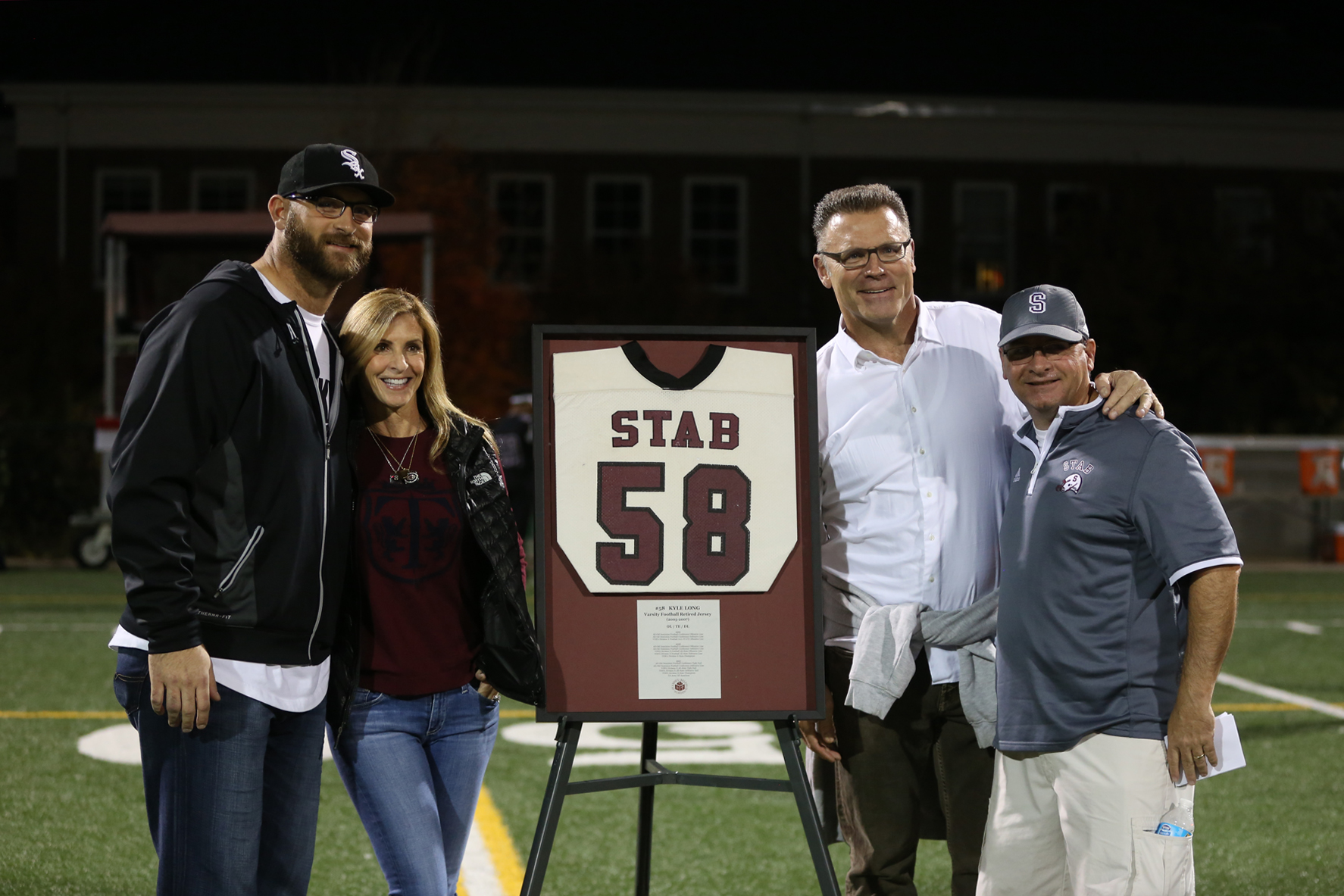
Blake, right, posing with Kyle Long and family after STAB retired Long’s jersey.
Blake has been just as creative from a schematic perspective. During White Pumpkin Hell season, the time of year around Halloween where the Saints chant White Pumpkin Hell at the end of games because of a tradition involving a white pumpkin and the Saints’ traditional white helmets, it’s a sure bet that you’re going to see some inventive gadget plays, a different approach to something. Like any coach, Blake is always looking for a wrinkle, something to give his team an edge. Unlike most coaches, Blake was willing to string a lot of those wrinkles together. Or throw the entire gameplan out if it wasn’t working, like in a game McChesney was in early in Blake’s tenure.
“A team was just pounding us with a basic power run game against our base 4-3 defense,” McChesney said. “During half time, Coach Blake implemented a new 5-2 with aggressive safety play, attacking linebackers, and heavy stunts up front … a defensive set we’d never discussed or practiced previously.”
It worked, as STAB flipped the script and got the win.
Blake’s competitiveness is otherworldly too. Back in 2015, the Saints were about to lineup with Blue Ridge in the final regular season game, knowing that a week later the Barons and Saints were going to face off in the state playoffs.
“We ran four plays and Jalen Harrison (STAB’s quarterback) finally came over to me and said can we please run something besides 46 and 47 and I’m going ‘Next week,’” Blake said.
The two high scoring editions of the Barons and Saints ended with a 14-10 STAB victory that day in St. George and a week later, the Saints won a 55-29 barnburner that took nearly three hours to play.
Beyond the scores and the chess matches though, Blake’s adult life has been intertwined with STAB and the football program. His oldest son Patrick, now an assistant on the Saints’ staff, was born during his first season and at two weeks old, Blake had to bring him to school, briefly passing him off to Carrington King, Nate Rullman and Jon Staunton — all arranged strategically to protect the infant — while he completed a task. STAB football was clearly a family affair for Blake, his wife Mary Blake (the school’s incredibly successful girls lacrosse coach who John assisted for years during the spring) and sons Patrick and Hunter.
“They both ran around these fields forever … it’s been great and that and my biggest fan (Mary) is here too,” Blake said.
You can always find Mary, often as keyed up as Blake himself, somewhere on the STAB sidelines, away from the action but living with every play, every decision, every mistake and every touchdown.
Football coaches are often casually referred to as molders of men, but Blake went beyond that charge and built teams, building them differently than a lot of people construct them, whether through strategy or seeing something other coaches didn’t see in certain players. He also instilled accountability, making the poem The Man In the Glass the lifeblood of the program, reading it before every single game. The poem talks about not cheating yourself by giving less than maximum effort. Blake’s team’s rarely fell short of their potential.
He also built chemistry.
“He brought the locker room together like no one I’ve seen before,” McChesney said. “He had a genuine talent for cultivating an atmosphere in which kids from various socio-economic backgrounds, or simply different groups of friends, became one when they stepped on the field.”
Family, chemistry, teamwork and accountability are at the bedrock for the Saints during Blake’s tenure. That’s why dozens of former players were there during Blake’s final home game at STAB, ready to celebrate a man who’d led them as teenagers and, for many, continued to guide them into adulthood. He did it by helping them become a part of something bigger than themselves.
“When I say he’s a giant to me, it’s an understatement,” Chris Long said on his podcast. “I’m pretty sure if you asked any player who played under him…he meant the same to all those guys. His impact is felt, probably subconsciously, even decades later. I know that I operate a certain way because of, at least in part, the foundation that was laid for me playing for Coach Blake.”
He’s a giant to hundreds of players. Even after the last White Pumpkin Hell chant rings out, it might be the end of his tenure, but the work Blake has done for 25 years will continue to ripple out and echo long after he’s done stalking the sidelines. When you pour that much love, enthusiasm, creativity and work into something, it can’t help but have an impact.
Maybe that’s the most important lesson Blake provided his players — meet the standard yourself that you set for others and the rest will follow.


